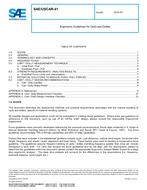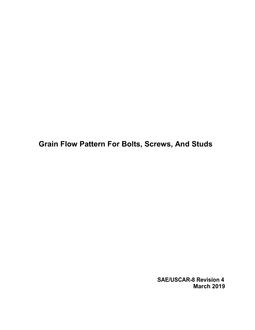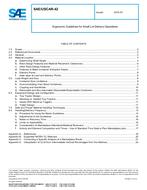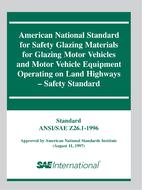Description
This SAE Recommended Practice describes motor vehicle driving automation systems that perform part or all of the dynamic driving task (DDT) on a sustained basis. It provides a taxonomy with detailed definitions for six levels of driving automation, ranging from no driving automation (level 0) to full driving automation (level 5), in the context of motor vehicles (hereafter also referred to as “vehicle†or “vehiclesâ€Â) and their operation on roadways. These level definitions, along with additional supporting terms and definitions provided herein, can be used to describe the full range of driving automation features equipped on motor vehicles in a functionally consistent and coherent manner. “On-road†refers to publicly accessible roadways (including parking areas and private campuses that permit public access) that collectively serve users of vehicles of all classes and driving automation levels (including no driving automation), as well as motorcyclists, pedal cyclists, and pedestrians.
The levels apply to the driving automation feature(s) that are engaged in any given instance of on-road operation of an equipped vehicle. As such, although a given vehicle may be equipped with a driving automation system that is capable of delivering multiple driving automation features that perform at different levels, the level of driving automation exhibited in any given instance is determined by the feature(s) that are engaged.
This document also refers to three primary actors in driving: the (human) user, the driving automation system, and other vehicle systems and components. These other vehicle systems and components (or the vehicle in general terms) do not include the driving automation system in this model, even though as a practical matter a driving automation system may actually share hardware and software components with other vehicle systems, such as a processing module(s) or operating code.
The levels of driving automation are defined by reference to the specific role played by each of the three primary actors in performance of the DDT and/or DDT fallback. “Role†in this context refers to the expected role of a given primary actor, based on the design of the driving automation system in question and not necessarily to the actual performance of a given primary actor. For example, a driver who fails to monitor the roadway during engagement of a level 1 adaptive cruise control (ACC) system still has the role of driver, even while s/he is neglecting it.
Active safety systems, such as electronic stability control and automated emergency braking, and certain types of driver assistance systems, such as lane keeping assistance, are excluded from the scope of this driving automation taxonomy because they do not perform part or all of the DDT on a sustained basis and, rather, merely provide momentary intervention during potentially hazardous situations. Due to the momentary nature of the actions of active safety systems, their intervention does not change or eliminate the role of the driver in performing part or all of the DDT, and thus are not considered to be driving automation.
It should, however, be noted that crash avoidance features, including intervention-type active safety systems, may be included in vehicles equipped with driving automation systems at any level. For Automated Driving System (ADS) features (i.e., levels 3-5) that perform the complete DDT, crash avoidance capability is part of ADS functionality.
Product Details
- Published:
- 06/15/2018
- Number of Pages:
- 35
- File Size:
- 1 file , 680 KB
- Redline File Size:
- 2 files , 4.8 MB






